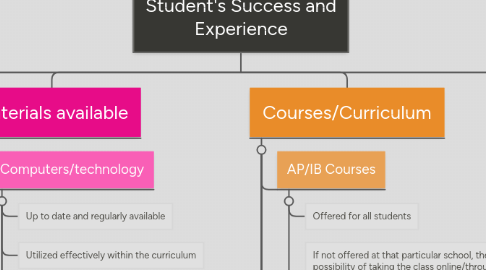
1. Environment
1.1. Neighborhood
1.1.1. Socio-economic status
1.1.2. Urban vs suburban
1.2. Building/Structure
1.2.1. Enough classrooms?
1.2.2. Theatres, gyms, sports fields, etc
1.2.3. Regular maintenance and updates
1.2.4. Large, well lit rooms
1.3. Diversity
1.3.1. Representative of the community?
1.3.2. Encouraged and explored within the classroom and academic environment
1.4. Class Size
1.4.1. Small sizes with enough classroom space
2. Materials available
2.1. Computers/technology
2.1.1. Up to date and regularly available
2.1.2. Utilized effectively within the curriculum
2.1.3. Enough to share between students
2.1.4. Access provided outside of the classroom for students who might not otherwise have access to special technology
2.2. Desks/classrooms
2.2.1. Enough desks for every student
2.2.2. Classrooms that are properly stocked and with enough space for a reasonable class size.
2.3. Textbooks
2.3.1. Physical textbooks offered
2.3.2. Enough physical or digital copies available for all students
2.3.3. Textbooks are up to date, accurate, and relevant
2.4. Equipped labs
2.4.1. Specialty labs are equipped with appropriate materials, ex: beakers and chemicals for chemistry, power tools for woodshop.
2.4.2. Enough materials for every student to have a fair opportunity to utilize equipment
2.4.3. Materials are maintained and current
2.5. Library
2.5.1. Well stocked with a variety of subject areas
2.5.2. Full access for students
2.5.3. Regularly updated with new texts
3. Administration
3.1. Teacher oversight
3.1.1. Amount of support administration offers individual teachers
3.1.2. Regularly checking in and reviewing courses and curriculum without micro-managing or nit-picking
3.1.3. Regular feedback and constructive reviews of instructors
3.2. Test scores vs overall learning
3.2.1. Focus on educating student beyond the tests
3.2.2. Encourage teachers to focus on doing more than just meeting test standards
3.2.3. Not penalizing instructors for low test scores
3.3. Counselors and support staff
3.3.1. Large number of counselors available to all students
3.3.2. Ability for students to meet regularly with counselors
3.3.3. Specialized counselors such as ESOL, Special ed
3.3.4. Additional support staff such as reading specialists, technology support staff, etc
3.4. Regular student interactions
3.4.1. Counselors meet regularly with student body
3.4.2. Principal and administration work closely with the student body to better understand needs
4. Teachers
4.1. Required Training
4.1.1. Certified through university programs
4.1.2. Alternative paths require additional training
4.1.3. Continued teacher education
4.2. Certifications
4.2.1. Child abuse certifications
4.2.2. CPR/First Aid certified
4.2.3. Certified to deal with different special needs
4.3. Instructional Freedom
4.3.1. Given direct control over class content
4.3.2. Ability to select materials
4.4. Salary/Tenure
4.4.1. Competitive salary
4.4.2. Regular pay increases based on experience
4.4.3. Not basing raising on test scores
4.5. Teacher relationships
4.5.1. Teachers communicate student progress and lesson plans
4.5.2. Sharing information and planning between content areas
5. Courses/Curriculum
5.1. AP/IB Courses
5.1.1. Offered for all students
5.1.2. If not offered at that particular school, the possibility of taking the class online/through another location is offered to all students with properly information available as to the possibilities
5.2. Electives
5.2.1. Variety of electives offered for multiples disciplines
5.2.2. Electives are fairly funded and appropriately equipped
5.2.3. Students are given equal opportunity to take these electives (a low achieving student has the ability to take computer science electives, and high achieving student should not be dissuaded from taking auto tech)
5.3. Advanced options
5.3.1. Students are able to continue on to more advanced courses based on performance, not grade level or age
5.3.2. If higher levels options are not offered at that particular school, alternative options (online, through other locations, community college, etc) are offered to the student
5.4. Trade classes
5.4.1. Are funded fairly and offered same credit opportunities as college track courses
5.4.2. Students are free to chose these classes as they see necessary
5.5. Instructors control over curriculum
5.5.1. Teachers are free to select individual class curriculum
5.5.2. State requirements and guidelines are followed within individual class curriculum, but not rigid structures
6. School Board and National Standards
6.1. Test Scores
6.1.1. Focus on high test scores vs holistic learning
6.1.2. Supports research based tests and curriculum, rather than "common sense" methods
6.1.3. Reaction to schools with suffering test scores
6.2. Funding
6.2.1. Method of funds distribution- do the schools that need the money most get it?
6.2.2. Funds appropriately based on need, not test scores, and acknowledging the difference greater funding can mae
6.2.3. Management of instructor and administrative pay
6.3. ESL/Special Ed requirements
6.3.1. Requires special attention and extra funding be put into these programs
6.3.2. Sets standards to ensure students that fall within these groups are given the necessary accommodations to succeed.

